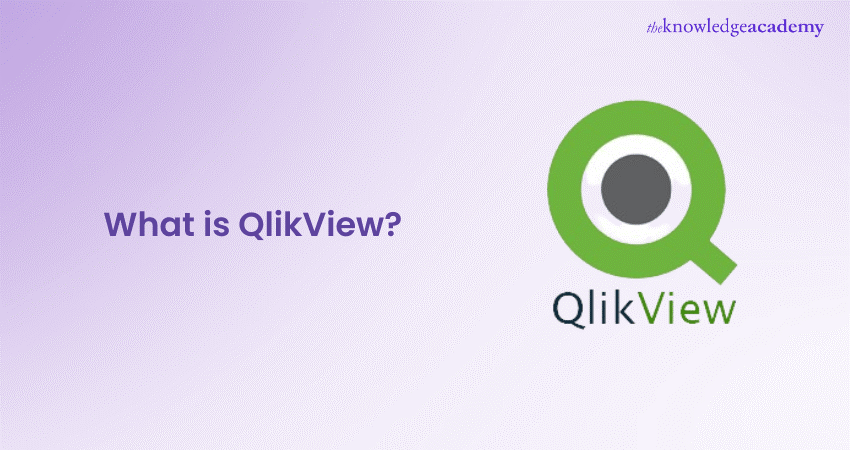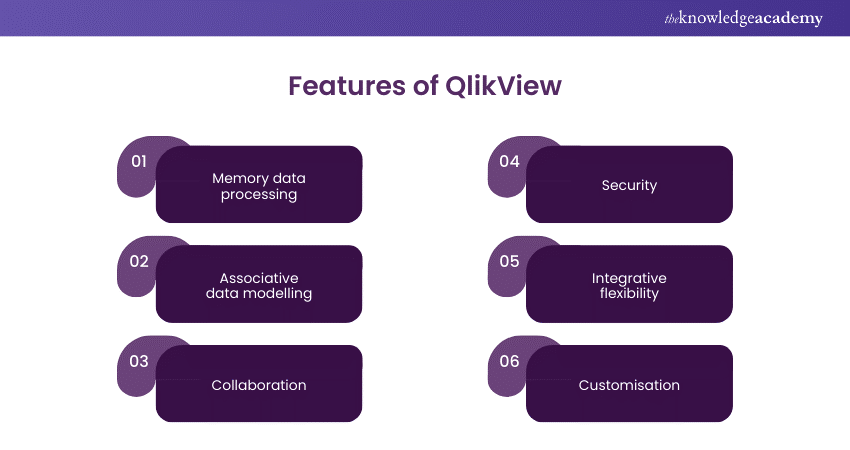We may not have the course you’re looking for. If you enquire or give us a call on + 800 908601 and speak to our training experts, we may still be able to help with your training requirements.
We ensure quality, budget-alignment, and timely delivery by our expert instructors.

QlikView is a Business Intelligence (BI) tool used for discovering and analysing data. It allows you to analyse complex datasets from multiple sources, like spreadsheets, databases, and other platforms. You can also use its built-in features to create captivating visuals representing your data. This blog will elaborate on "What is QlikView?" and why it's gaining popularity in the business world.
Table of Contents
1) What is QlikView?
2) What makes QlikView so popular?
3) The evolution of QlikView
4) Features of QlikView
5) Architecture of QlikView
6) Benefits of QlikView
7) Drawbacks of QlikView
8) Conclusion
What is QlikView?
QlikView is a Business Intelligence Platform developed by Radnor, Pennsylvania. The software is designed to help you to analyse complex datasets. It can analyse data from several sources like spreadsheets and databases.
Further, it lets you compare the data obtained from multiple sources simultaneously. Once analysed, QlikView can assist you in making interesting visual representations of your data. In addition, you can use it to enhance the appeal of your dashboards and presentations.
sed between QlikView and Qlik Sense? Get the insights you need to make an informed decision! Click here for a detailed comparison.
What makes QlikView so popular?
Now, you might wonder why QlikView is gaining popularity. It is because it's a very easy-to-use platform that offers a creative business solution. The option of generating data visuals helps many business professionals to reinvent their presentations. It is fast and accurate, and the best part is that it has no data limit.
Hence, you can easily process large amounts of data quickly. It allows you to analyse data from any platform; if you have data on any platform, QlikView can analyse it. Besides, it can streamline the data from several platforms into one for easy access. This makes it a great business solution for professionals who deal with data daily.
Dive into QlikView architecture! Explore the components and structure that make QlikView a top choice for data visualization. Get started now!
The evolution of QlikView
QlikView was developed in 1993 by Bjorn Berg and Staffan Gestrliu in Sweden. They were a team of entrepreneurs who started a company to create a tool that would enable quick and easy Data Analysis.
The first two versions of QlikView were written in Excel using VLOOKUPs. Now, QlikView has grown tremendously and has thousands of customers across many countries. Moreover, it has established partnerships with companies like Intel and HP.
Take your Data Analysis skills to the next level with our Qlik Sense Training – Sign up now!
Features of QlikView
QlikView is known for its amazing features. Here’s a list of user-friendly features of QlikView:

1) Memory data processing: You can store large amounts of data, allowing fast data processing and analysis. The data is safely stored for you to re-visit at any time.
2) Associative data modelling: You can access data non-linearly and use it to create dashboards and insights. This allows you to navigate your data without being confined to predefined paths.
3) Collaboration: The application software allows you and your team to collaborate. You can share your insights with each other and make additions to your data together.
4) Security: QlikView offers safe storage for your important data as they understand how your corporate documents are sensitive information.
5) Integrative flexibility: QlikView offers you flexibility in building dashboards and using scripts for mapping according to your requirements.
6) Customisation: QlikView allows you to customise your experience with your data. It allows you to build custom dashboards, reports, and charts with drag-and-drop functions.
Transform your career path with our Business Intelligence Reporting Courses – register today!
Architecture of QlikView
To grasp the essence of QlikView, let's delve into its architectural framework. QlikView's architecture primarily consists of three main components, each playing a crucial role in its functionality. Let’s explore the Architecture of QlikView:
Desktop QlikView
The Desktop QlikView serves as the front end, empowering users to manipulate data, incorporate links, and effortlessly transform data into user-friendly output.
QlikView Server (QVS)
The QlikView Server acts as the host, facilitating communication between clients and users. Supported by a robust QLX Engine, it ensures efficient in-memory Data Analysis, Management, distribution, and access.
Get ready to impress with our comprehensive list of QlikView interview questions and answers.
Publisher QlikView
Publisher QlikView offers an optional mobile version, enabling users to retrieve and analyse data on the go. This feature streamlines task distribution and scheduling, reducing unnecessary data load and traffic for effective dissemination.
QlikView Control Panel
The QlikView Control Panel, a web-based interface, is controlled by IT professionals, providing centralised management of all QlikView components.
Unlock Hidden Features! Check Out Our Qlik Sense Tips and Tricks for Smarter Data Visualization!
User Access QlikView
The User Access QlikView serves as the access point, facilitating easy management of multiple data files via a web browser. It ensures that when accessing data from backend servers, the original data format remains intact while documents created using these files are saved with the .qvw extension.
Benefits of QlikView
QlikView offers numerous advantages that cater to various needs. Here are some of its key benefits:
1) Revenue Analysis: QlikView enables analysis of revenue data using various filters for large multinational corporations like Shell, Panasonic, Toyota, and more.
Unlock the potential of your data with Qlik Sense! Learn about its features and how it can elevate your business intelligence strategy. Click to find out more!
2) Enhanced decision-making: QlikView tools simplify decision-making by predicting cause and effect using diagrams and historical data.
3) Social media reporting: QlikView generates detailed visual reports from social media responses from customers worldwide.
4) Data Analysis: QlikView facilitates the analysis of information such as sales, inventory production, shipping, and product quality. Essentially, any process and related data can be logged and analysed.
5) Reporting flexibility: QlikView allows easy creation of reports for strategic, operational, and tactical analysis.
Equip yourself with essential Qlik Sense interview questions to boost your confidence.
Drawbacks of QlikView
In this section, we will explore the drawbacks of QlikView:
1) Reloading data needs a considerable workload as it bulk loads all the data to the system's RAM. This process takes a long time to set up.
2) ETL capabilities required for more complex data integration are not offered on this platform yet.
3) Some advanced capabilities to produce highly formatted reports are still unavailable on QlikView.
4) It is designed to produce interactive analysis. However, the program isn’t the best for writing reports for analysis.
5) You will need to use macros to create a formatted report to duplicate and maintain QlikView objects.
6) It’s a simple analysis and reporting tool. However, it does not allow you to write back to the database.
Upskill your Data Visualisation capabilities with our QlikView Training – sign up today!
Conclusion
We hope you read and understand "What is QlikView?" and why it is so popular. It is a powerful Data Visualisation and Analysis tool that empowers users to make informed decisions and drive business growth. As organisations continue to harness the power of data, QlikView remains a vital asset in their journey towards success.
Transform your career path with our Business Intelligence Reporting Courses – register today!
Frequently Asked Questions
Why choose QlikView?

QlikView is the most cost-effective among its competitors, which helps you produce high-quality visualisation of your analysis at a lower cost. It's easy to use with its user-friendly tools that anyone who doesn’t particularly have a technical business background can still easily use.
Why should you learn QlikView?

QlikView is considered the best Data Visualisation software on the market. It allows you to create insightful charts, reports and dashboards. It does so with speed and simplicity.
What are the other resources and offers provided by The Knowledge Academy?

The Knowledge Academy takes global learning to new heights, offering over 3,000 online courses across 490+ locations in 190+ countries. This expansive reach ensures accessibility and convenience for learners worldwide.
Alongside our diverse Online Course Catalogue, encompassing 19 major categories, we go the extra mile by providing a plethora of free educational Online Resources like News updates, Blogs, videos, webinars, and interview questions. Tailoring learning experiences further, professionals can maximise value with customisable Course Bundles of TKA.
What is Knowledge Pass, and how does it work?

The Knowledge Academy’s Knowledge Pass, a prepaid voucher, adds another layer of flexibility, allowing course bookings over a 12-month period. Join us on a journey where education knows no bounds.
What are related Business Intelligence Courses and blogs provided by The Knowledge Academy?

The Knowledge Academy offers various Business Intelligence Reporting Courses, including Qlik Sense Training, MicroStrategy 10 Training and Microsoft Power BI Training. These courses cater to different skill levels, providing comprehensive insights into Business Intelligence Platforms.
Our Office Application Blogs cover a range of topics related to QlikView, offering valuable resources, best practices, and industry insights. Whether you are a beginner or looking to advance your Business Intelligence Reporting skills, The Knowledge Academy's diverse courses and informative blogs have you covered.
Upcoming Office Applications Resources Batches & Dates
Date
 QlikView Training
QlikView Training
Fri 28th Feb 2025
Fri 4th Apr 2025
Fri 11th Jul 2025
Fri 19th Sep 2025
Fri 21st Nov 2025






 Top Rated Course
Top Rated Course



 If you wish to make any changes to your course, please
If you wish to make any changes to your course, please


